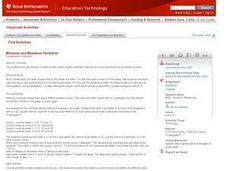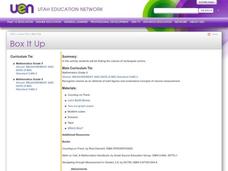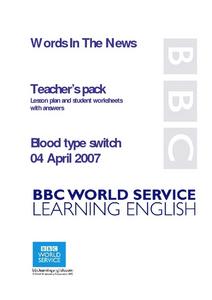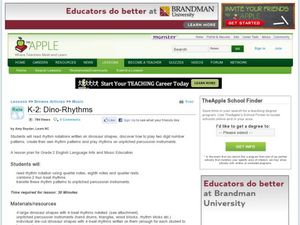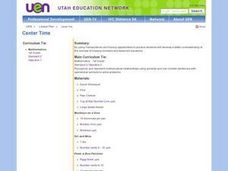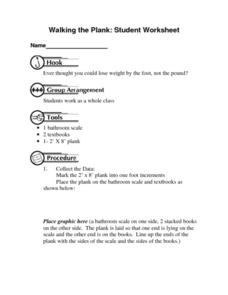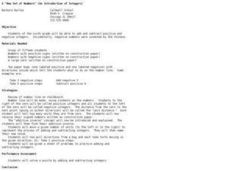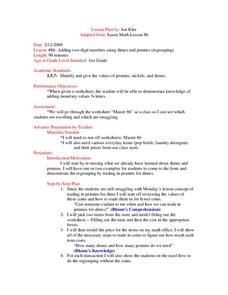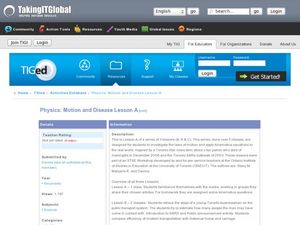Curated OER
Minimum and Maximum Perimeter
Pupils practice a variety of strategies with varying numbers of tiles to form shapes and then find the minimum and maximum perimeter for each one. Each group is assigned a different area to build either with square tiles or a geoboard....
Curated OER
Multiplication Versus Addition
Second graders create arrays to study multiplication. In this multiplication lesson, 2nd graders split into teams to complete a multiplication table. One team uses addition to solve the table while the other uses multiplication. Students...
Curated OER
Box It Up
Fifth graders make boxes. In this prisms lesson, 5th graders read the book Counting on Frank and discuss the different things that the boy measures. Students make boxes of various sizes using graph paper and find their volume.
Curated OER
Flying Disk Golf
Learners participate in flying disc golf. In this sports lesson, students use one hoop and a flying disk to land the disk in the hoop. Learners play in partners.
Curated OER
Acting Like a Hog
Students explore game theory. In this secondary mathematics lesson, students investigate the playing of a game called Hog which involves rolling dice. Students explore many different scenarios as they consider the best...
Curated OER
Map Your Community
Learners study their community's assets and needs to create a service project that would meet the needs. In this community project lesson, students research their community and look for the strengths and weaknesses of the community. As a...
Curated OER
Blood type Switch
High schoolers read a text about blood groups and answer such questions as what, where and why regarding a scientific discovery. They complete vocabulary worksheets, comprehension exercises and utilize problem solving skills to decide...
Curated OER
That's So Square
Students familiarize themselves with the three most common geometric shapes: circles, triangles and parallelograms. They sketch, sort, and name the shapes.
Curated OER
Money Bags
Third graders explore different combinations of coins that can be used for specified amounts of money using paper money and tree diagrams. They write money amounts in different forms. Groups utilize a tree diagram imbedded in this lesson...
Curated OER
Life Science: Human Body Skit
Learners create skits based on the human body systems. Working in groups, they role-play as organs in the various systems. They make costumes or wear signs identifying themselves as the organs in their skits.
Curated OER
Trading in Subtraction
Second graders solve two-digit subtraction problems without trades using counters and by modeling trades with base-ten blocks. They pair in groups and students open the "Counters Open Mat". Students are given a problem, such as: there...
Curated OER
A Newspaper?
Sixth graders use newspapers to investigate fractions. They work in small groups to categorize articles, measure them with the grid transparency, and calculate the values represented. Afterward, they write a reflective essay on the role...
Curated OER
Parts of a Set
In this numerator and denominator worksheet, 4th graders write the fraction for the shaded parts of seven different sets of shapes. Students shade part of two sets of shapes to show the fraction amount given and answer one word problem.
Curated OER
Let's Talk Trash
For this solid waste worksheet, learners classify the different types of solid wastes found in landfills into given categories. Students predict and tally the total number of each type of item found in the landfill using slips of paper....
Curated OER
What Are The Odds?
Students read the book, Jim Ugly, and discuss whether the odds were in favor of or against the character Jake finding his dad. They demonstrate an experiment involving odds by keeping a tally of how many times a colored die is pulled out...
Curated OER
Study Guide-Skeletal System
In this skeletal system worksheet, students answer 16 questions about the functions of the skeletal system, the groups of bones that make up the skeletal system, the parts of the bones, the joints, the components of the bones and the...
Curated OER
K-2: Dino-Rhythms
Second graders read rhythm notation and combine four-beat rhythms. In this rhythms lesson, 2nd graders read quarter notes, eighth notes, and quarter rests in rhythms that are written on dinosaur shapes. They clap, snap, or stamp out the...
Curated OER
The Kingdoms
Students review the various categories in taxonomy. In groups, they identify the characteristics of each kingdom and compare and contrast them. They define the terms binomial nomenclature and morphology. To end the lesson, they create...
Curated OER
Center Time
First graders recognize and represent mathematical relationships using symbols and use number sentences with operational symbols to solve problems. They complete various activities such as tug of war, monkeys on a vine, and hit and miss....
Curated OER
Walking the Plank: Student Worksheet
In this math worksheet, students will work in a group to experiment with the weight of objects when placed at a distance from a scale (using a plank). Students will record and graph their results.
Curated OER
A New Set of Numbers
Sixth graders add and subtract positive and negative integers. In this integers math activity, 6th graders review the number line as a class, with students representing the numbers and moving in a positive or negative direction to find...
Curated OER
Adding Two-Digit Numbers Using Dimes and Pennies
First graders examine regrouping when adding, by using dimes and pennies to borrow. In this addition lesson, 1st graders work together as a whole group, working together with the teacher.
Curated OER
Introduction to Hours & Minutes
First graders identify, interpret, and gain proficiency in using a clock to tell time to the hour and determine how many minutes are in an hour. They identify and list what they do as they travel through their dayand how much time you...
Curated OER
Physics: Motion and Disease
High schoolers read media and identify examples of science technology and society. In this physics lesson, students learn about acceleration and velocity. High schoolers estimate how many people would have come in contact with a...
